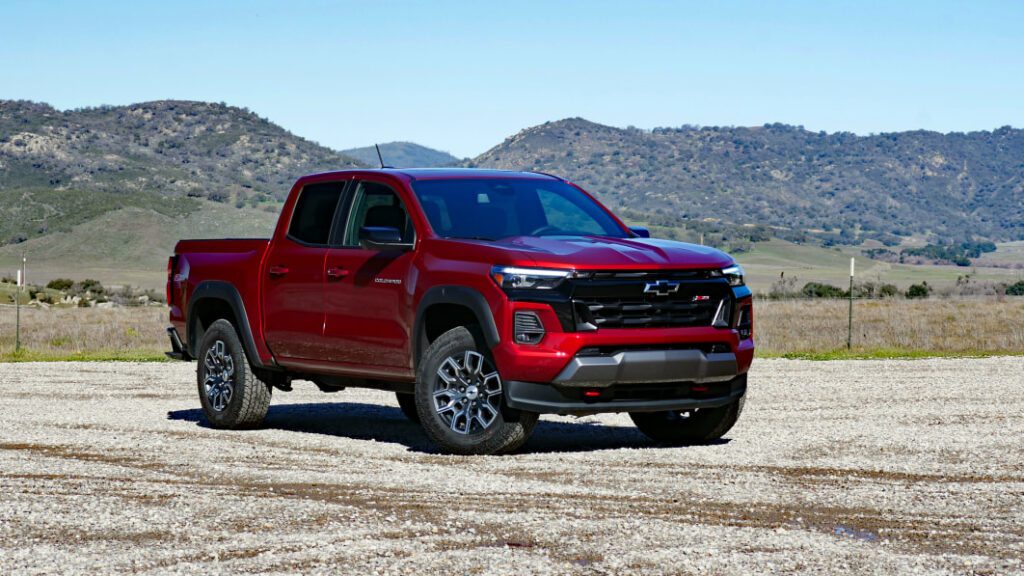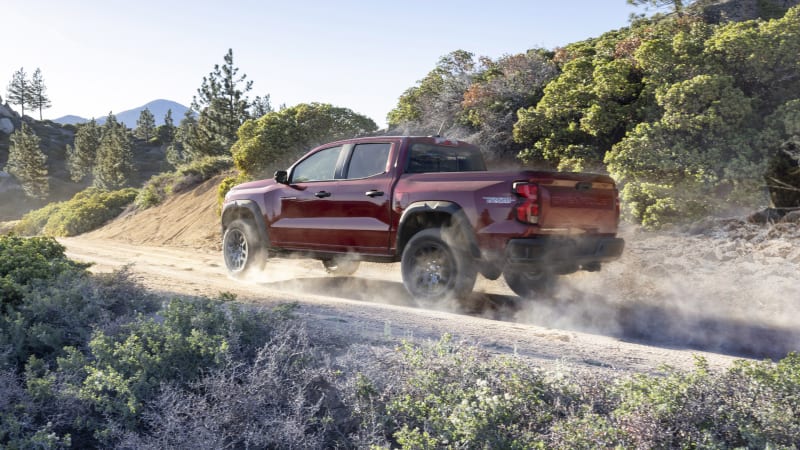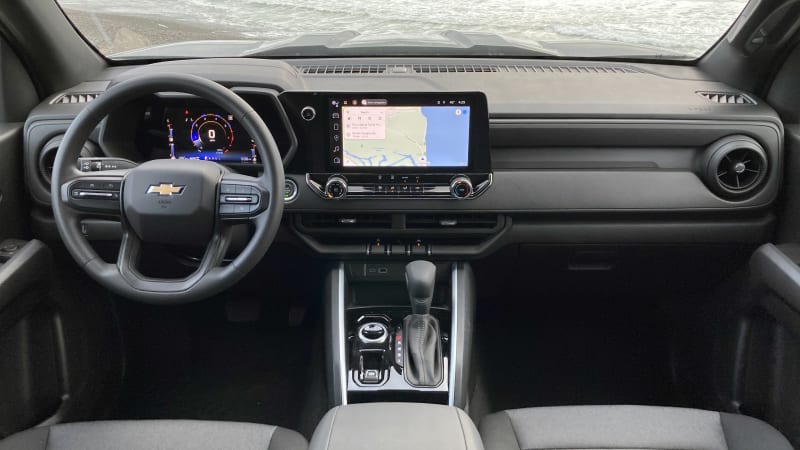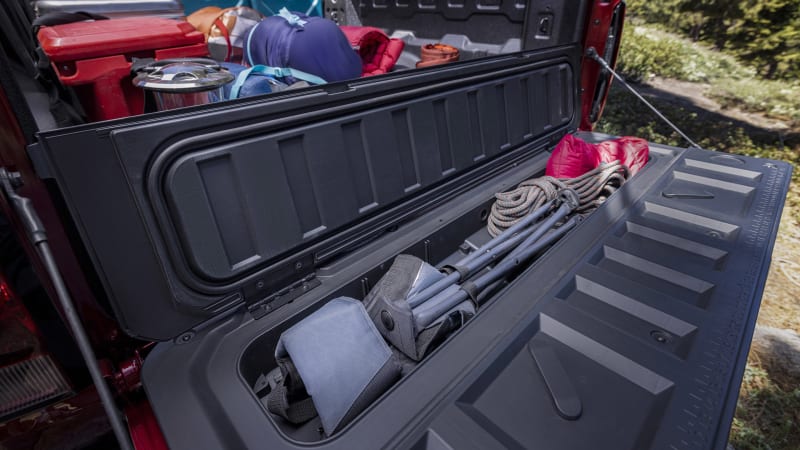2023 Chevy Colorado First Drive Review: Little truck gets a big overhaul

JULIAN, Calif. – The all-new, 2023 Chevrolet Colorado might seem like it’s following on the heels of its big brother, the Silverado, but don’t be so sure. You see, while it’s true that the current-generation Silverado was the first Chevy truck to get GM’s 2.7-liter turbo engine three years ago, the big four was actually developed with the next-generation Colorado in mind. It was also the Colorado’s new interior that influenced the design direction of the Silverado’s quasi-emergency redo a year ago – not the other way around. Basically, we’ve been getting a slow preview of this midsize pickup without even knowing it.
This is important because it illustrates that Chevy intended for the Colorado to be a more distinctive, less Mini Me type of midsize truck. At least the Silverado didn’t steal its exterior styling cues, which are more youthful, athletic and tougher without going over the top with machismo (see Silverado HD). You can see the influence of the Toyota Tacoma here, or at least the influence of how much more successful it is despite not being particularly good. People who buy those do so in part because it is smaller than a full-sizer, appreciating the superior maneuverability and off-road capability. They also dig the accompanying look that definitely isn’t just a miniaturized Tundra.
This new Colorado is far more Tacoma-like in that regard, while being a lot better at the sort of basic things Toyota’s wildly popular little pickup isn’t. The driving position isn’t glued to the floor like the Tacoma’s, the backseat legroom is sufficient, interior technology is state-of-the-art courtesy of Google, the ride is smoother, and the engine is quieter and more efficient. Its hill-descent control also doesn’t sound like small weapons fire is emanating from under the front bumper when in operation. Which is all to say that the Colorado is trying to steal some of the Tacoma’s lunch money, and if there’s any justice in the world, it absolutely should. It’s a better truck.
With that obvious comparison out of the way, though, let’s dig deeper into this all-new Colorado’s particulars. That 2.7-liter turbocharged inline-four is now the only engine available, replacing the old truck’s naturally aspirated inline-four and V6, and turbodiesel. “Only engine” isn’t exactly accurate, though, as there are three states of tune. The base version, standard on the Work Truck and LT trim levels, produces 237 horsepower and 259 pound-feet of torque. While obviously superior to the old sad sack NA four banger (200 hp, 191 lb-ft), it nevertheless feels on the gutless side and suffers from extreme throttle delay accompanied by an awfully mushy pedal. Maybe it was just our particular test truck, but this version of the engine may need some tweaking.
The mid-level version or “2.7 Turbo Plus” isn’t just a software flash – there are indeed extra parts involved, including a piston-cooling squirter that’s not needed in the lower output version, and several noise-quelling bits of foam. There are nevertheless different 1s and 0s involved, too, and it all amounts to an engine that produces 310 hp and 390 lb-ft of torque. That would be more power than the outgoing V6 and more torque than the old turbodiesel. That sure sounds like mission accomplished, at least on paper.
Out on the road, this 2.7 responds much better to throttle inputs and is suitably gutsy for a truck. Chevy estimates that most trim levels and drivetrain combos should hit 60 mph in less than 7 seconds. The eight-speed automatic does tend to upshift too quickly when momentarily lifting off the throttle while traveling on a grade (a sport mode would be nice, though there is a Tow/Haul mode that should in theory address that while towing and/or hauling).

Chevy says Silverado customers complained that the 2.7-liter didn’t sound enough like a truck engine, so engineers tried to address that in the Colorado (by 2024, the 2.7-liter will be identical in both trucks). If you think a truck engine should sound like a diesel, well, mission accomplished there too, since you get a very turbodiesel-like wastegate whistle followed by the growl of the engine kicking it. All that premature upshifting can make this noise a bit annoying in certain steady-state cruising situations as every throttle tip-in is accompanied by the whistle-growl. With a heavier foot, though, the 2.7 still totally sounds like a direct-injected four-cylinder engine. A duck is a duck is a duck. At least it’s a really powerful duck.
And it can get even more powerful with the 2.7 Turbo High Output, this time 100% the result of a software flash that you can actually get from a dealer after your initial purchase. It produces the same 310 hp, but torque gets kicked up to 430 lb-ft. This is the setup that will come standard on the range-topping, desert-storming ZR2, which we did not get to drive this go-around, but all other trims can be optioned with it. Yes, even the Work Truck.
Taking a look at the trim lineup, it’s clear just how popular off-roading is to midsize truck buyers (or at least the appearance of being able to off-road). Of the six Colorado trim levels, four are of the more rugged variety. The Trail Boss, a new trim that actually was inherited from Silverado, builds off the Work Truck’s surprisingly decent feature content with a 2-inch factory lift, a 3-inch-wider track, standard four-wheel drive, off-road drive modes (Off-Road for slick surfaces and Terrain for rougher ones), an automatic locking rear diff, hill-descent control, recovery hooks, and unique styling elements including bigger fender flares, lots of gloss black trim and 18-inch wheels wrapped in all-terrain rubber. We drove a Trail Boss with the optional mud terrain tires, which didn’t add as much extra noise as we were expecting, but you do notice the firmer reactions to pavement imperfections that in turn send more vibrations through the truck’s frame. Besides that, this body-on-frame pickup with rear leaf springs comports itself well in terms of both ride and handling. It’s reasonably composed, comfortable and civilized.
Its midsize dimensions also make it far more maneuverable than a full-sizer, a fact that we probably appreciated most while traversing a rutted trail east of San Diego. We didn’t have to worry about scraping the paint on shrubs, and it was much easier to avoid big rocks or ruts. There’s absolutely no comparison while parking.

On the other hand, you’re obviously giving up a ton of space by going with the Colorado versus a Silverado. The Colorado also only offers one body combination now: crew cab and what previously would’ve been known as a short bed. Its 61.7-inch length is best-in-class for a short bed, but if you want a long bed with a crew cab, you’ll need to go with a Tacoma or Nissan Frontier.
Inside, it’s a very good thing that the Silverado got its version of this design motif first, because we all would’ve been writing “the Colorado now has a better interior than the pricier Silverado.” As it is, they are certainly related aesthetically, but the cheaper Colorado has a lot more hard plastic throughout, most notably on the doors and center console. The right side of the dash has it, too, in the Work Truck and Trail Boss (pictured above), but it gets replaced by nice, padded pleather in the LT and Z71 with color-accent stitching.
Every Colorado does, however, feature the same 11.3-inch touchscreen as upper trim level Silverados, including its operating system by Google. Navigation is therefore the Google Maps interface you’re used to, natural voice commands come courtesy of Google Assistant, and the overall user interface is easy enough to figure out. We appreciate, though, that GM has kept its same general radio layout featuring virtual preset buttons under song/station info. As a refresher, the operating system may be a common Android Automotive one shared by multiple brands, but it’s reskinned so that a Chevrolet and Volvo don’t look or even function totally the same.


It also gets unique feature content, including off-road-specific vehicle info pages and a multitude of available camera angles. The Colorado Z71, which is basically a ritzier Trail Boss, can add a unique under-body camera and a low-mounted forward camera to go with the regular forward and rear cameras available on the Trail Boss. You can split these various feeds (the two forward feeds would’ve been particularly helpful when inching up to a blind drop-off if the lower camera hadn’t been caked in mud), or go with side-by-side views of the front or rear wheels.
Other highlights include a damped tailgate with an available storage compartment and the ability to stop half-way in its travel to prop up a long surfboard, plywood, etc. The front overhang is also shorter now and the spare tire lifted higher off the ground, improving approach and departure angles, respectively. It also once again has a removable front air dam for improved clearance, but it’ll definitely be less necessary now as it doesn’t dangle as perilously close to the ground. The creatively scalloped hood doesn’t just look interesting, but it’s a compromise between the aesthetic preferences for a tough-guy, high-hood look and visibility benefits of a lower hood.
Back in 2019, we placed the outgoing Colorado third out of four in a midsize truck comparison test. We appreciated its ride, handling and utility, but found its engine to be just OK and its interior in serious need of a modernization and quality improvement. Well, those positives have been maintained and those negatives have been addressed. Would it be enough to topple that test’s winner, the then-new (for the U.S., anyway) Ford Ranger? We can’t know for sure, but the odds would be in its favor considering its comparable pricing. At the very least, we would’ve greatly preferred the Colorado’s appearance. Oh, and by the way: The truck that came in last in that comparison nearly four years ago? That would be the Tacoma. It really shouldn’t stand a chance now … as long as customers are willing to give this Colorado a chance.
Related video:



